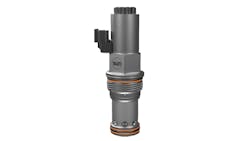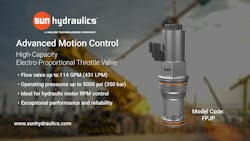Sun Hydraulics FPJP Cartridge Valve Meets Market Demand for Higher Flow Rates
The Sun Hydraulics FPJP cartridge valve is a pilot-operated, normally closed electro-proportional throttle valve. It is designed to provide precise proportional control at high flow rates of 114 gpm (431 lpm), helping to meet market demand for hydraulic components capable of providing higher flow rates and operating pressures.
Per Sun Hydraulics, the valve provides consistent flow control in proportion to an electrical command signal. The valve features the company’s floating nose construction which minimizes the risk of internal parts binding due to excessive installation torque or machining inconsistencies and thus helps to ensure reliable performance.
The FPJP cartridge valve can be used in a wide range of industrial and mobile equipment sectors. Application uses include hydraulic motor speed control in water spraying trucks, orbital motors on conveyers, or fan control on agricultural spreaders and seeders.
Other features of the FPJP cartridge valve include:
- operating pressures up to 5,000 psi (350 bar)
- reverse free-flow check
- coils interchangeable with other Sun full flow, solenoid-operated valves
- optimized lap construction to minimize hysteresis and improve stability
- highly repeatable fluid flow
- broad flow ranges to enable efficient operation
- integrated damping for enhanced control loop tuning
- compact cartridge design allows streamlined manifold layouts and reduces system complexity.
About the Author
Sara Jensen
Executive Editor, Power & Motion
Sara Jensen is executive editor of Power & Motion, directing expanded coverage into the modern fluid power space, as well as mechatronic and smart technologies. She has over 15 years of publishing experience. Prior to Power & Motion she spent 11 years with a trade publication for engineers of heavy-duty equipment, the last 3 of which were as the editor and brand lead. Over the course of her time in the B2B industry, Sara has gained an extensive knowledge of various heavy-duty equipment industries — including construction, agriculture, mining and on-road trucks —along with the systems and market trends which impact them such as fluid power and electronic motion control technologies.
You can follow Sara and Power & Motion via the following social media handles:
X (formerly Twitter): @TechnlgyEditor and @PowerMotionTech
LinkedIn: @SaraJensen and @Power&Motion
Facebook: @PowerMotionTech

Leaders relevant to this article:


